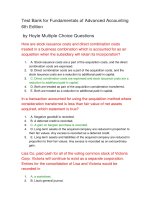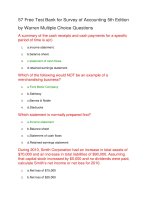Advanced accounting, 5th edition international student version ch11
Bạn đang xem bản rút gọn của tài liệu. Xem và tải ngay bản đầy đủ của tài liệu tại đây (968.03 KB, 53 trang )
11
11
International Accounting and the
Global Economy
Advanced Accounting, Fifth Edition
Slide
11-1
Learning
Learning Objectives
Objectives
1.
Describe how the changing world environment is leading to an increased
focus on international financial reporting standards (IFRS).
2.
Explain some of the major differences between IFRS and U.S. GAAP.
3.
List some of the milestones that must be achieved before the SEC will
require adoption of IFRS.
4.
Describe the SEC’s work plan for incorporating IFRS into the financial
reporting system for U.S. issuers.
5.
Describe three major joint convergence topics between the IFRS and
FASB.
Slide
11-2
Learning
Learning Objectives
Objectives
6.
List the steps that a non-U.S. company must follow to list its shares on a
U.S. stock market.
7.
Explain the role of form 20-F filed with the Securities and Exchange
Commission.
8.
Indicate the role of American Depository Receipts in the issuing of
securities of non-U.S. companies in the United States.
Slide
11-3
The
The Increasing
Increasing Importance
Importance of
of International
International
Accounting
Accounting Standards
Standards
Securities and Exchange Commission (SEC)
June 2007, eliminated the need for foreign private
investors to reconcile their financial statements to U.S.
generally accepted principles (GAAP) if the issuers use
International Financial Reporting Standards (IFRS).
July 2007, voted unanimously to publish a concept
release for comment on allowing U.S. issuers to prepare
their financial statements using IFRS as issued by the
IASB.
Slide
11-4
LO 1 Increased focus on International Accounting Standards.
The
The Road
Road To
To Convergence-U.S.
Convergence-U.S. GAAP
GAAPand
and IFRS
IFRS
September 2002, FASB and the IASB issued their Norwalk
Agreement including a “memorandum of understanding.”
April and October 2005; November 2009, FASB and the
IASB reaffirmed their commitment to the convergence of
U.S. GAAP and IFRS.
September 2008, IASB and FASB issued a progress report
and timetable for completion, recognizing the relevance of a
roadmap for the removal of the reconciliation requirement for
non-U.S. companies using IFRS.
Slide
11-5
LO 1 Increased focus on International Accounting Standards.
The
The Road
Road To
To Convergence-U.S.
Convergence-U.S. GAAP
GAAPand
and IFRS
IFRS
November 14, 2008, SEC released a roadmap for the
adoption of IFRS by U.S. issuers.
February 24, 2010, SEC issued a release, Commission
Statement in Support of Convergence and Global Accounting
Standards. The SEC stated its continued belief that a single
set of high-quality globally accepted accounting standards
would benefit U.S. investors.
May 26, 2011, SEC released a staff paper discussing
possible work plans for incorporating IFRS into the financial
reporting system.
Slide
11-6
LO 1 Increased focus on International Accounting Standards.
The
The Road
Road To
To Convergence-U.S.
Convergence-U.S. GAAP
GAAPand
and IFRS
IFRS
The basis for considering the use of IFRS by U.S. issuers
include the following milestones.
1.
Improvements in accounting standards;
2.
Accountability and funding of the IASC Foundation;
3.
Improvement in the ability to use interactive data for IFRS reporting;
4.
Education and training relating to IFRS.
Slide
11-7
These four milestones relate to issues that need to be
addressed before adoption of IFRS by U.S. entities can occur.
LO 3 SEC milestones to be achieved for adoption of IFRS.
The
The Road
Road To
To Convergence-U.S.
Convergence-U.S. GAAP
GAAPand
and IFRS
IFRS
Work Plan for Incorporating IFRS
The work plan for incorporating IFRS into the financial reporting system
includes:
1.Full adoption of IFRS on a specified date, without any endorsement
mechanism.
2.Full adoption of IFRS following staged transition over several years.
3.An option for U.S. issuers to apply IFRS.
4.Retaining U.S. GAAP with continued convergence efforts, with or without
a specific mechanism in place to promote alignment with IFRS.
5.Retaining a U.S. standard-setter (condorsement).
Slide
11-8
LO 4 SEC’s work plan for incorporating IFRS
The
The Road
Road To
To Convergence-U.S.
Convergence-U.S. GAAP
GAAPand
and IFRS
IFRS
Improvement in Accounting Standards
It is important that the accounting standards
Slide
11-9
be established under a robust, independent process that includes
careful consideration of possible alternative approaches.
be established with due process, which allows for input from and
consideration of views expressed by affected parties, including
investors.
are timely to keep standards current and reflect emerging accounting
issues.
produced are capable of improving the accuracy and effectiveness of
financial reporting and the protection of investors.
LO 1 Increased focus on International Accounting Standards.
The
The Road
Road To
To Convergence-U.S.
Convergence-U.S. GAAP
GAAPand
and IFRS
IFRS
Accountability and Funding of the IASC Foundation
The IASB is established to develop global standards for financial reporting.
Slide
11-10
Oversight is by the IASC Foundation, a stand-alone, not-for profit
organization, which is responsible for the activities of the IASB and
is governed by 22 trustees whose backgrounds are geographically
diverse.
Initially IASB operations were financed through voluntary
contributions by approximately 200 organizations.
A majority of the IASB’s finances are now based on national financing
regimes, proportionate to a country’s relative GNP.
Further progress on financing is essential to safeguard the IFRS
Foundation’s position as the world’s independent accounting standard
setter.
LO 1 Increased focus on International Accounting Standards.
The
The Road
Road To
To Convergence-U.S.
Convergence-U.S. GAAP
GAAPand
and IFRS
IFRS
Ability to Use Interactive Data For IFRS Reporting
In May 2008, the SEC proposed rules to require companies to
provide their financial statements to the Commission as well as on their
corporate Web sites in interactive data format using the eXtensible
Business Reporting Language (“XBRL”).
In April 2011, the SEC acknowledged that it would be impossible for
foreign private issuers using IFRS and filing with the SEC to file in
XBRL because the SEC had not approved the IFRS XBRL taxonomy.
During March 2011, the IFRS Foundation finalized a 2011 IFRS
taxonomy but the SEC had not yet granted approval.
Slide
11-11
LO 3 SEC milestones to be achieved for adoption of IFRS.
The
The Road
Road To
To Convergence-U.S.
Convergence-U.S. GAAP
GAAPand
and IFRS
IFRS
Education and Training
A requirement for U.S. issuers to report in accordance with IFRS would
increase the need for effective training and education about IFRS for a
number of groups, including investors, accountants, auditors and
others involved in the preparation and use of financial statements, due
to differences between U.S. GAAP and IFRS.
Slide
11-12
LO 3 SEC milestones to be achieved for adoption of IFRS.
The
The Road
Road To
To Convergence-U.S.
Convergence-U.S. GAAP
GAAPand
and IFRS
IFRS
Adoption Approaches
1. Full Adoption of IFRS – countries recognize IFRS as issued by
the IASB as GAAP.
2. Adopt IFRS after Some Incorporation Process – allows each
country to address country-specific issues. This results in the
following:
Convergence approach: jurisdictions maintain their local
standards but work to converge with IFRS over time.
Endorsement approach: jurisdictions incorporate individual
IFRS into local standards.
Slide
11-13
LO 4 SEC’s work plan for incorporating IFRS
The
The Road
Road To
To Convergence-U.S.
Convergence-U.S. GAAP
GAAPand
and IFRS
IFRS
Adoption Approaches
3. “Condorsement” of IFRS – focus of the SEC’s work plan,
predicated on several principles:
U.S. GAAP would be retained, but the FASB would incorporate
IFRS into U.S. GAAP over a defined period, with a focus on
minimizing transition costs.
The FASB would incorporate newly issued IFRS into U.S.
GAAP pursuant to some established endorsement protocol.
There may be a need for U.S. interpretations of IFRS on
issues that are significant in the U.S. but not in the
Slide
11-14
remainder of the world.
LO 4 SEC’s work plan for incorporating IFRS
The
The Road
Road To
To Convergence-U.S.
Convergence-U.S. GAAP
GAAPand
and IFRS
IFRS
Timing of Future Rulemaking by the Commission
By the end of 2011, the SEC plans to decide whether to proceed with
rules requiring some U.S. public companies to file IFRS-based financial
statements.
The AICPA Board of Examiners announced that IFRS would be eligible
for testing on the Uniform CPA Exam starting in 2011.
Slide
11-15
LO 4 SEC’s work plan for incorporating IFRS
Significant
Significant Similarities
Similarities and
and Differences
Differences
In general,
U.S. GAAP are considered to be more rules-based, while
IFRS is considered to be more principles-based,
although this dichotomy is an over-simplification as most U.S.
rules are rooted in principles, and the IASB is embracing more
interpretative details of its principles over time.
Slide
11-16
LO 2 Differences between IFRS and U.S. GAAP.
GAAP
GAAPHierarchy-U.S.
Hierarchy-U.S. Versus
Versus IFRS
IFRS
U.S. GAAP Hierarchy—Effective September 2009
Authoritative: Included in the FASB Accounting
Standards Codification
Non-Authoritative: Not-included in the FASB Accounting
Standards Codification
Exceptions: SEC registrants must also follow SEC rules and
regulations issued under the authority of federal securities
laws.
Slide
11-17
LO 2 Differences between IFRS and U.S. GAAP.
GAAP
GAAPHierarchy-U.S.
Hierarchy-U.S. Versus
Versus IFRS
IFRS
IFRS Hierarchy (issued by the IASB)
1. IFRS/IAS statements (8 IFRS and 41 IAS standards) and
IFRIC/SIC Interpretations (32 SIC and 14 IFRIC). SIC stands for
the Standards Interpretations Committee.
2. Apply a method that is relevant, reliable, represents faithfully the
financial position, the performance, and cash flows of the firm;
reflect the economic substance of the firm.
3. Look to recent pronouncements of other standard setters which
use a similar conceptual framework (i.e., U.S. GAAP).
4. The conceptual framework.
Slide
11-18
LO 2 Differences between IFRS and U.S. GAAP.
GAAP
GAAPHierarchy-U.S.
Hierarchy-U.S. Versus
Versus IFRS
IFRS
Similarities and Differences between FASB and IASB
Slide
11-19
LO 2 Differences between IFRS and U.S. GAAP.
GAAP
GAAPHierarchy-U.S.
Hierarchy-U.S. Versus
Versus IFRS
IFRS
Slide
11-20
LO 2 Differences between IFRS and U.S. GAAP.
GAAP
GAAPHierarchy-U.S.
Hierarchy-U.S. Versus
Versus IFRS
IFRS
Slide
11-21
LO 2 Differences between IFRS and U.S. GAAP.
GAAP
GAAPHierarchy-U.S.
Hierarchy-U.S. Versus
Versus IFRS
IFRS
Slide
11-22
LO 2 Differences between IFRS and U.S. GAAP.
GAAP
GAAPHierarchy-U.S.
Hierarchy-U.S. Versus
Versus IFRS
IFRS
Slide
11-23
LO 2 Differences between IFRS and U.S. GAAP.
GAAP
GAAPHierarchy-U.S.
Hierarchy-U.S. Versus
Versus IFRS
IFRS
Slide
11-24
LO 2 Differences between IFRS and U.S. GAAP.
GAAP
GAAPHierarchy-U.S.
Hierarchy-U.S. Versus
Versus IFRS
IFRS
Slide
11-25
LO 2 Differences between IFRS and U.S. GAAP.









